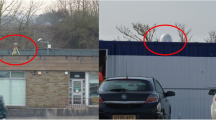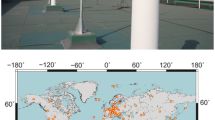Abstract
One application in structural engineering is measuring the movement of suspension bridges. Under unfavourable wind conditions or heavy traffic loads cable suspension bridges may move up to a few metres. Therefore, a positioning system used to monitor bridge movements can provide extremely valuable information. For such monitoring applications it is desirable for the positioning system to deliver equal precision in all position components, all the time.
GPS has the potential to deliver cm-level positioning accuracy, through use of the very precise carrier-phase measurement. However, the same level of accuracy cannot be guaranteed in all three-position components, twenty-four hours a day, in every situation.
Additionally, GPS signals are very weak and easily obstructed, especially in built-up urban environments. One solution to improving the GPS satellite geometry and the availability of ranging signals is to use ground-based transmitters of GPS-like signals (called “pseudolites”). A major advantage of pseudolite devices is the ability to control where they are located, improving a geometrically poor GPS constellation.
In this paper proof of concept for the use of pseudolites in the monitoring of suspension bridges is demonstrated through an experimental trial conducted on the Parsley Bay suspension footbridge in Sydney, Australia.
Access this chapter
Tax calculation will be finalised at checkout
Purchases are for personal use only
Preview
Unable to display preview. Download preview PDF.
Similar content being viewed by others
References
Barnes, J., J. Wang, C. Rizos, T. Nunan, C. Reid (2002a). The development of a GPS/pseudolite positioning system for vehicle tracking at BHP Billiton steelworks. In: Proc of 15th International Technical Meeting of the Satellite Division of the US Inststitute of Navigation (ION-GPS 2002), 24–27 September, Portland, Oregan, pp. 1779–1789.
Barnes, J., J. Wang, C. Rizos, T. Tsujii (2002b). The performance of a pseudolite-based positioning system for deformation monitoring. In: Proc of 2nd Symposium on Geodesy for Geotechnical & Structural Applications, 21–24 May, Berlin, Germany, pp. 326–337.
Dai, L., J. Zhang, C. Rizos, S. Han, J. Wang (2000). GPS and pseudolite integration for deformation monitoring applications. In: Proc of 13th International Technical Meeting of the Satellite Division of the US Institute of Navigation (ION-GPS 2000), 19–22 September, Salt Lake City, Utah, pp. 1–8.
Dodson, A.H., X. Meng, G. Roberts (2001). Adaptive method for multipath mitigation and its applications for structural deflection monitoring. In: Proc of international Symposium on Kinematic Systems in Geodesy, Geomatics and Navigation (KIS2001), 5–8 June 2001, Banff, Alberta, Canada, pp. 101–110.
Meng, X. (2002). Real-Time Deformation Monitoring of Bridges Using GPS/Accelerometers. PhD thesis, The University of Nottingham, Nottingham, UK, 239 pp.
Meng, X., G.W. Roberts, A.H. Dodson, E. Cosser, C. Noakes (2002). Simulation of the effects of introducing pseudolite data into bridge deflection monitoring data. In: Proc of 2nd Symposium on Geodesy for Geotechnical and Structural Engineering, 21–24 May 2002, Berlin, pp. 372–381.
Wang, J., T. Tsujii, C. Rizos, L. Dai, M. Moore (2001). GPS and pseudo-satellites integration for precise positioning. Geomatics Research Australasia, 74, pp. 103–117.
Wang, J., T. Tsujii, C. Rizos, L. Dai, M. Moore (2000). Integrating GPS and pseudolite signals for position and attitude determination: Theoretical analysis and experiment results. In: Proc 13th International Technical Meeting of the Satellite Division of the US Institute of Navigation, 19–22 September, Salt Lake City, Utah, pp. 2252–2262.
Author information
Authors and Affiliations
Editor information
Editors and Affiliations
Rights and permissions
Copyright information
© 2005 Springer-Verlag Berlin Heidelberg
About this paper
Cite this paper
Barnes, J. et al. (2005). The Integration of GPS and Pseudolites for Bridge Monitoring. In: Sansò, F. (eds) A Window on the Future of Geodesy. International Association of Geodesy Symposia, vol 128. Springer, Berlin, Heidelberg. https://doi.org/10.1007/3-540-27432-4_15
Download citation
DOI: https://doi.org/10.1007/3-540-27432-4_15
Publisher Name: Springer, Berlin, Heidelberg
Print ISBN: 978-3-540-24055-6
Online ISBN: 978-3-540-27432-2
eBook Packages: Earth and Environmental ScienceEarth and Environmental Science (R0)




